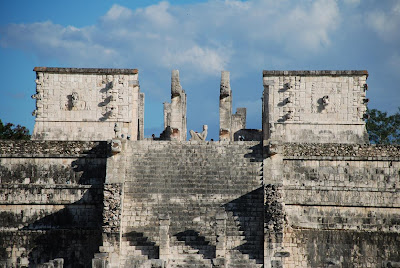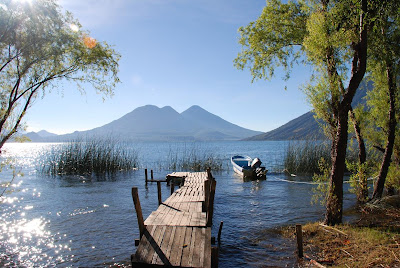Well, it's been over a month since my last post - apologies all - but lots seems to have happened and there's always so little time to get on a computer. So, whilst I am waiting for Hannah to arrive, I'll pick up where I left off with a perhaps overly in-depth look at rehab at ARCAS. Feel free just to look at the pictures......

Yucatan Black Howler Monkey
The rehabilitation of animals at ARCAS can be a very quick, or very lengthy, process - it depends on the species.
1) Reptiles

Juvenile crocs awaiting feeding, weighing and measuring
Reptiles tend to be the easiest kind of animals to rehabilitate. This is because they do not form attachments with humans and after the appropriate medical and physical care, they can be released. In terms of crocodiles, this means until they reach at least 1 metre in length; for turtles, a certain weight has to be reached. In the meantime, they are kept in cages with pools that are cleaned on a weekly basis, and are fed chicken. Nobody gets very close, especially to our big croc, which is 1.5m long (crocs start seeing humans are food once they reach 1.8m in size). We now have 10 baby crocodiles, all about 30cm in length, which are fed chicken twice a week depending on the weather (less sun = less feeding). Our large croc was removed from an area of Lago Peten Itza close to an upmarket hotel - at the moment we are awaiting permission to relocate it, possibly to the Mayan site at Yaxha.
Here's one we prepared earlier......
2) Birds
For the rehabilitation of birds, the physical and medical elements are the most important and difficult stages. Each year ARCAS receives 300-400 birds - the vast majority being parrots, with a few toucans and other birds, usually for illegal export to be kept as pets. They are usually very young (stolen from their nests at a few weeks of age), dehydrated and under-nourished. Of the slightly older birds that have started to grow flight feathers, these are often clipped. In reality, approximately 85% of parrots captured died before they reach maturity.
At ARCAS, juvenile birds are fed a blended mix of fruit, rice, beans and maize, 5 to 6 times per day when they are young. As they get older the frequency of feeds decreases and they are moved onto a solid food diet, usually of banana or orange, plus a rice/beans/maize mix. As they get older still, they receive a daily amount of wild berries from the jungle, so they become accustomed to what they should be eating. Once birds have a full set of flight feathers and are big enough, they are released into larger cages where the are able to use their wings properly and fly. Here they are still closely monitored for signs of illness, bullying or feather plucking.

One of the several parrot species at ARCAS
Birds are then moved out of quarantine to a pre-rehabilitation cage where their contact with humans decreases, and their flying and perching ability increases. The pre-rehab cages are large and parrots may remain there for some time until permission is received from CONAP to release them into the wild. Then the birds are moved to a large 50m by 20 enclosure, 6m high, for a month. Here they have no human contact - they are fed once daily before it gets light - and quickly adapt to their surroundings. After 1 month they can be released, usually in a site distant from human habitation.
So what are the problems? Initially in quarantine birds have to overcome the stress of their capture and transport. Juvenile parrots tend to suffer from fungal infections because of the damp environment in the small quarantine cages (usually 50-100 cm per side); in the wild, they would tend to be high up in a sunnier, better ventilated canopy. Getting full sets of flight feathers is also a problem. If the bird arrives with clipped wings, they have to be at least 8 months old before these feathers can be removed - until that age there is a blood vessel inside the core of the feather. It then takes 3 months to regrow a set of flight feathers (after a series of vitamin A, D3 and E injections); if some feathers have been clipped then usually all the flight feathers need to be removed in stages a few weeks apart so a completely new set are grown. The other problem is that for several months at least birds are in regular contact with people, and so it is essential that when feeding and cleaning the birds you do not talk or interact with them - they are quick learners and birds that for strong bonds with people cannot be released.
Other birds at ARCAS include several keel-billed toucans - photos below - and scarlet macaws. There are only 180 breeding pair of scarlet macaws left in the wild in the Yucatan/Guatemala/ Belize area, although throughout the rest of Central and South America they are less threatened. ARCAS is a member of the "Guacamayas sin Fronteras" - Macaws without Borders - project that hopes to reintroduce rehabilitated birds into the wild, and also replace wild young that die with hand reared young that will be fostered by the parent birds. At the moment there are some 15 macaws awaiting reintroduction to the wild at ARCAS; the biggest problem is the need to get samples from wild birds to test for diseases that may be transferred to or from the wild birds. There is also a breeding programme of 4 pairs of macaws that this year have all successfully raised their young - although none were used as replacements in the wild due to lack of samples mentioned above.

Keel-billed toucan
3) Small Mammals
The small mammals at ARCAS vary in size, nature and diet. During my time there we had racoons, coatimundis, greater grisons, tayras, wild pigs and a kinkaju. All these animals are quite easy to rehabilitate physically and medically as they tend to be quite adaptable and eat almost anything. As with other ARCAS animals, most are caputured when being smuggled out of the Peten region for the international pet trade.
In the wild, racoons are ominvores and are fed as such at ARCAS - a mixture of bananas, rice, dog bisuits, chicken and eggs. Coatis get a fruit-based diet with some dog biscuits; in the wild their diet in fruit and insect based. Tayras and grisons, both part of the stoat/weasel family (but bigger) are also omnivores, and have a similar diet to the racoons. Kinkajus are noctural, tree dwelling (and very cute), who eat mainly fruit but really love dog biscuits.
The wild pigs were of 2 species - white lipped and white collared peccary - that during my time there had some problems. The white collared peccaries - the first to be cared for at ARCAS - both died within 2 weeks of each other of unexplained causes. Based on clincial signs and gross post mortem results we were suspicious of neurotoxins possibly from food (or a fungal toxin) or an infectious disease. At the time or writing, the hand-reared white lipped peccary also had 2 episodes of similar signs but had not died - the cause remains a mystery.
Although the small mammals tend to be easy to rear (with the exception of pigs!), they form human attachments very easily and are difficult to release in the wild unless far, far from humans. Because there are only a few to be released at a time and they are not threatened in the wild, expensive expeditions to far-off national parks cannot be justified. So instead, most small mammals are released at a private reserve, close to Flores, that has just 1000 acres of primary rainforest. Here there are no humans (except the odd tourist bus), which makes it an ideal habitat for the animals released there. In October we released 3 racoons, 3 coatis and 8 guans at the Park nears Flores. Our kinkaju remains in captivity, recently joined by another 2 (they live in groups of 7-15 in the wild) and hopeful for release in a few months.
At ARCAS there are also a number of white tailed deer - not exactly a small mammal, I know - kept for a breeding programme and planned re-introduction into the wild.
4) Felines

The hand-reared ocelot
There are 4 types of cat at ARCAS, ranging from almost domestic cat sized to really quite big! Of the two smaller species we have a jaguarundi and six margays; of the larger, there are 3 ocelots and one friendly, slightly overweight, jaguar.
Of the cats, only the 2 smaller species ever stand a real chance of being released. Both margays and jaguarundis need a small range to live in (several square kilometres), which make it possible for them to be released on private reserves like the small mammals.

Cum-chu, the ARCAS jaguar, not at her friendliest
Unfortunately, habitat pressures mean that ocelots and jaguars stand little chance of being released in the near future. Jaguars have a normal range of up to 100 square kilometres, and in the current circumstances across the Mexico/Guatemala/Belize region, there are too many problems with wild jaguars that need to be dealt with before release of rehabilitated animals can be considered. Principal pressures in the wild are the conflict between conservation of forested areas and farming, and jaguars killing farming stock. At the moment, studies are under way to tag several jaguars with GPS collars that can track their true range, especially in correlation with farm animal kills, in the hope that an accurate picture of the damage they may, or may not be inflciting becomes apparent. At ARCAS, 2 ocelots have been in captivity too long to allow their release into the wild; the third has been hand reared and this also makes it very unlikely that she can be released. The jaguar, Cum-chu, was found as a baby and hand reared; even without the problems existing for her release into the wild, ARCAS has neither the money or the space to train an adult jaguar to hunt and fend for herself.



















































